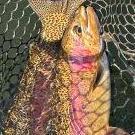Tournaments keep the Grand Glaize arm of the
Nearly every weekend, a bass tournament is held at the Lake of the Ozarks State Park Grand Glaize Public Beach 2 (also known as PB2). The popular access area hosts most of the major tournaments that visit the lake and countless club, buddy and charity events. The constant releasing of fish around the access area keeps the Glaize arm stocked with plenty of keeper bass (15 inches or longer) and some trophy fish. The biggest bass I’ve ever taken from the
Lake Ozark, MO, angler Greg West estimates the average size bass an angler can expect to catch on the Glaize during the winter runs from 2 1/ 2 to 4 pounds. In a fall tournament last year on the Glaize, West and his partner caught a five-fish limit weighing 18 pounds. “It can produce a 16- to 20-pound stringer if you catch it at the right time,” says the tournament competitor.
The Grand Glaize arm runs about 16 miles from its confluence with the Osage arm to the swinging bridges area where the tributary narrows down to a stream. The arm contains several large branches and hollows throughout its length including Watson Hollow, Red Bud Hollow, Brushy Hollow Cove,
“There aren’t as many docks on the Glaize but there are a lot more brush piles,” says West. A large section of the Glaize arm runs through the wooded and undeveloped
Starting in December, West relies on one lure to catch bass throughout the winter. He opts for a Chompers twin-tail plastic grub that he attaches to either a 3/8- or 1/ 4- ounce jighead. If it’s a calm warm day he will try the 1/ 4-ounce jig, but on windy days or if the fish have moved into deeper water he switches to the 3/8-ounce model to stay in better contact with his lure. He usually ties his grubs on 8-pound test line although he will upgrade to 10-pound test in murky water.
West’s favorite hues for his Chompers grubs are root beer green flake on sunny days or green pumpkin in overcast weather. He also dips the tails in chartreuse dye.
“When the fish get in the brush piles during the winter months I just drag that thing slowly,” says West of his presentation. With this tactic, West can work an area thoroughly yet still cover a lot of water. The fish will be 20 to 25 feet deep on main lake humps and ridges throughout most of the winter.
During the cold months, West prefers fishing the upper half of the Glaize. “The farther up you go the better, but you have to get into some coves that have deep water,” he recommends. “If they keep dropping the lake too much then you have to keep coming back down lake. His favorite stretch for wintertime fishing is from
The brown Jewel Eakins’ Pro Model Jig tipped with a Chompers twin-tail grub also produces for West during early winter on the Glaize. When the water turns colder, the other predominant winter pattern is slowly twitching a Suspending Rattlin’ Rogue (silver-and-black, silver-and-blue and clown) over brush piles or along steep rocky banks.
The patterns usually remain stable throughout most of the winter when the fish congregate on the structure. “When the water gets colder in January and February the fish start stacking up and you might fish four rounded points and not get a bite, but then the fifth point will have fish bunched up on it,” says West.
The water color on the Glaize arm usually has more color to it than the other arms of the lake during the winter. “It is a little murky,” describes West. “You can usually see down about 1 foot to 1 1/ 2 feet.”
Since so many bass are released around the PB2 area, the lower end of the Glaize usually receives the heaviest fishing pressure. West notes the pressure diminishes the farther you run up the Glaize.
Other areas of the
For information on lodging and other facilities at the Lake of the Ozarks or to receive a free vacation guide, call the Lake of the Ozarks Convention & Visitors Bureau at 1-800-FUN-LAKE or visit the Lake of the Ozarks Convention and Visitors Bureau web site at funlake.com.
Copies of John Neporadny's book, "THE Lake of the Ozarks Fishing Guide" are
available by calling 573/365-4296 or visiting the web site www.jnoutdoors.com.



Recommended Comments
Create an account or sign in to comment
You need to be a member in order to leave a comment
Create an account
Sign up for a new account in our community. It's easy!
Register a new accountSign in
Already have an account? Sign in here.
Sign In Now